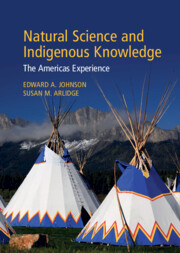Book contents
- Natural Science and Indigenous Knowledge
- Natural Science and Indigenous Knowledge
- Copyright page
- Contents
- Contributors
- Preface
- 1 What Do Indigenous People Have to Tell Us about the Cultural Landscapes They Have Created?
- 2 Reintegrating Cultural and Natural Landscapes
- 3 “My Uncle Was Resting His Country”: Dene Kinship and Insights into the More Distant Past
- 4 Native American Science in a Living Universe: A Paiute Perspective
- 5 “To Get More Harvest”
- 6 Hunting and Trapping in the Americas: The Assessment and Projection of Harvest on Wildlife Populations
- 7 On Fire and Water: The Intersection of Wetlands and Burning Strategies in Managing the Anthropogenic Plant Communities of Yosemite National Park
- 8 Indigenous Knowledge and the Kindergarten to Twelfth-Grade Science Classroom
- Index
- References
1 - What Do Indigenous People Have to Tell Us about the Cultural Landscapes They Have Created?
Published online by Cambridge University Press: 11 April 2024
- Natural Science and Indigenous Knowledge
- Natural Science and Indigenous Knowledge
- Copyright page
- Contents
- Contributors
- Preface
- 1 What Do Indigenous People Have to Tell Us about the Cultural Landscapes They Have Created?
- 2 Reintegrating Cultural and Natural Landscapes
- 3 “My Uncle Was Resting His Country”: Dene Kinship and Insights into the More Distant Past
- 4 Native American Science in a Living Universe: A Paiute Perspective
- 5 “To Get More Harvest”
- 6 Hunting and Trapping in the Americas: The Assessment and Projection of Harvest on Wildlife Populations
- 7 On Fire and Water: The Intersection of Wetlands and Burning Strategies in Managing the Anthropogenic Plant Communities of Yosemite National Park
- 8 Indigenous Knowledge and the Kindergarten to Twelfth-Grade Science Classroom
- Index
- References
Summary
What do Indigenous peoples have to tell us about the cultural landscapes they have created by their Indigenous knowledge. Human land-use changes impact physical and biological processes at different scales, creating a legacy of cultural footprints on the landscape. Indigenous populations have occupied the Americas for at least the last 30,000 years. They have adapted to an environment that had previously not been occupied by humans. Indigenous populations were seen by European colonizers in the 1400s as inferior people with no written language, primarily stone tools, and a different spiritual system and were therefore seen as having no sophisticated culture compared with the colonists’ European culture. Further European epidemic diseases caused major decreases in Indigenous populations and major destruction of their culture. This cultural destruction has continued into the twenty-first century. Indigenous peoples, however, had their own well-developed cultures that had created a large number of domesticated plants and had developed complex agricultural systems that supported large populations and increasingly sophisticated land-use and culture. This was all cut short by the arrival of European colonizers who could not recognize a culture different from their own. Today, we have started to understand the similarities and differences between the culture of science and that of Indigenous knowledge, which resulted from the development of both in isolation of the other. This book’s objective is to consider how Indigenous populations have lived and managed the American landscape. They have left a footprint that is a combination of their empirical knowledge and their spiritual culture.
Keywords
- Type
- Chapter
- Information
- Natural Science and Indigenous KnowledgeThe Americas Experience, pp. 1 - 6Publisher: Cambridge University PressPrint publication year: 2024



